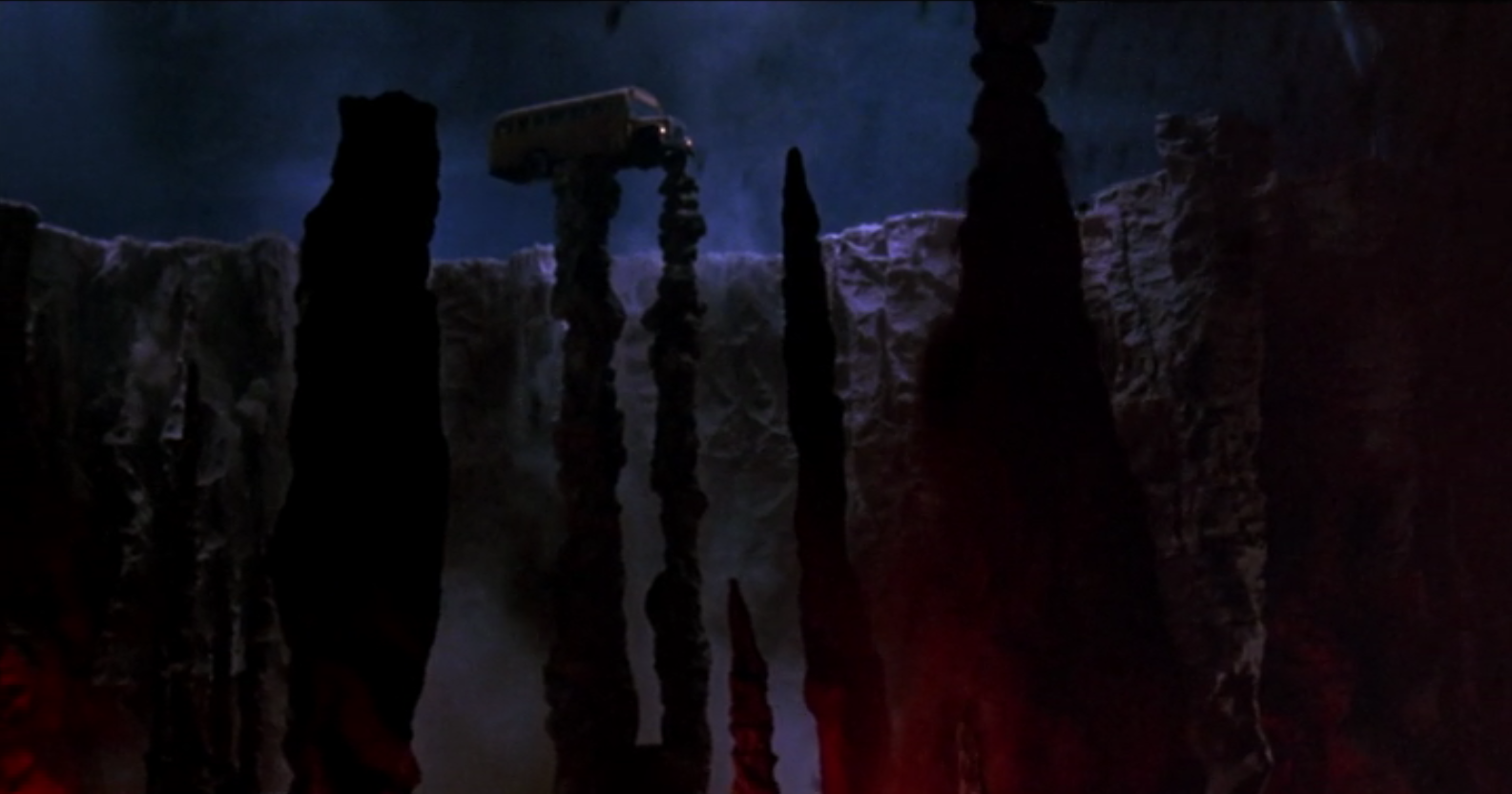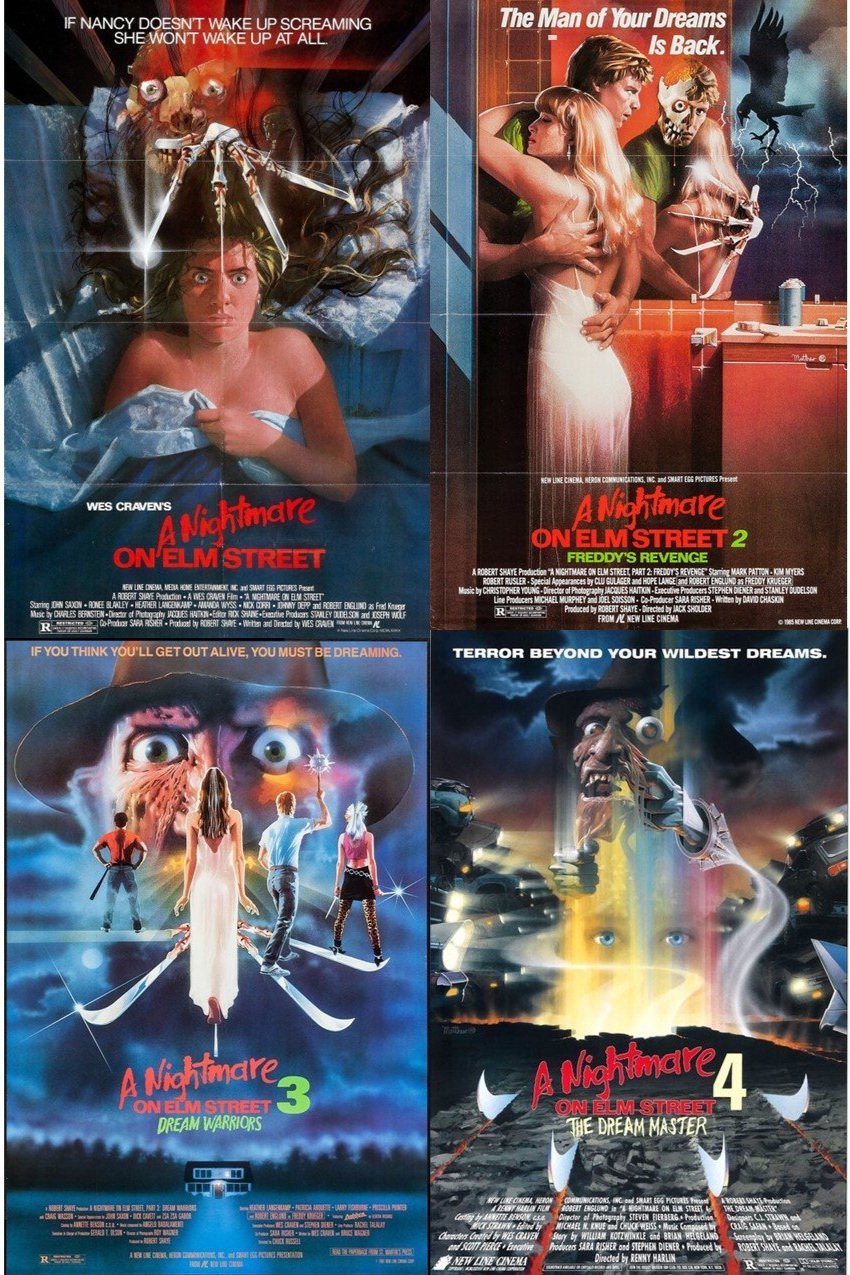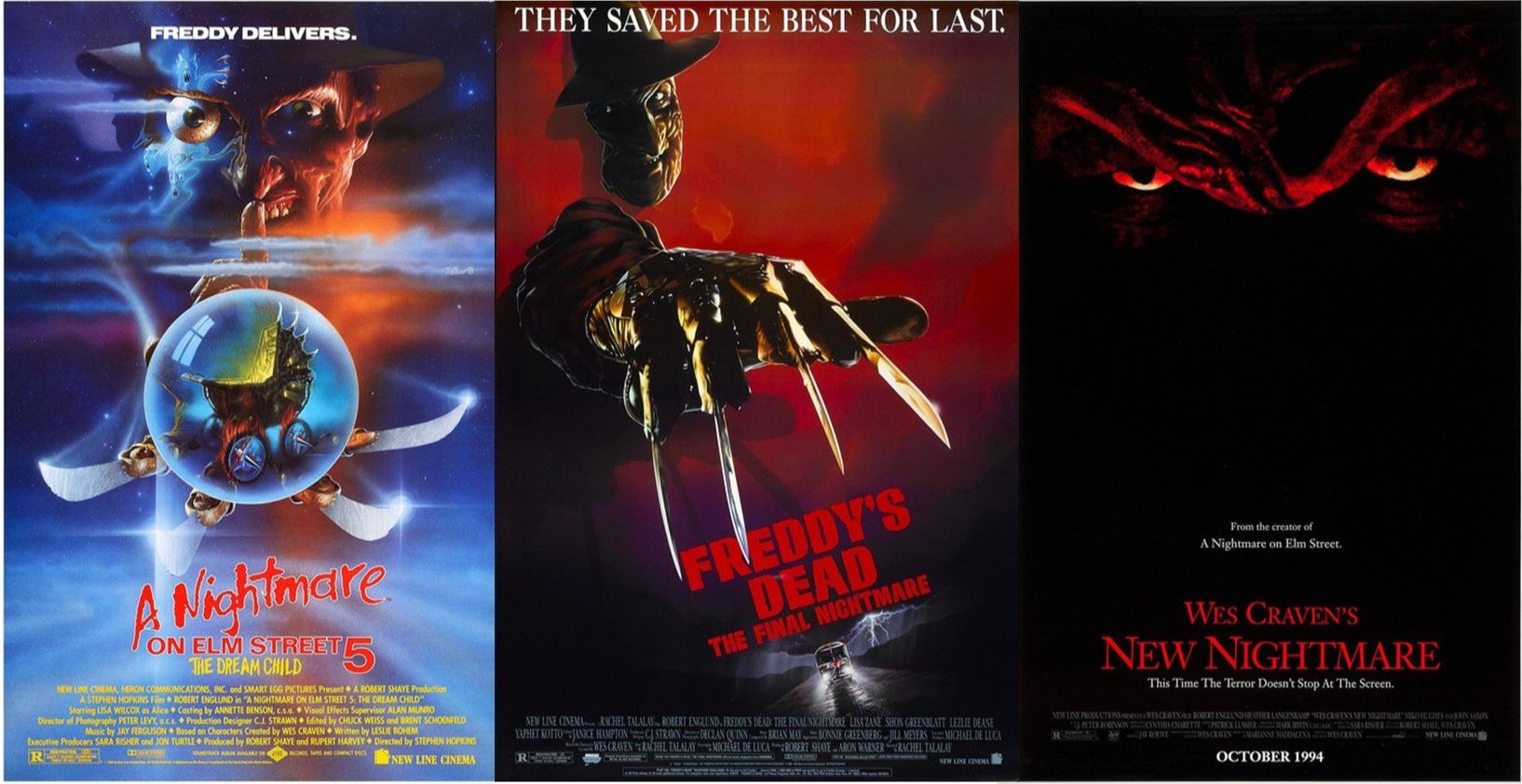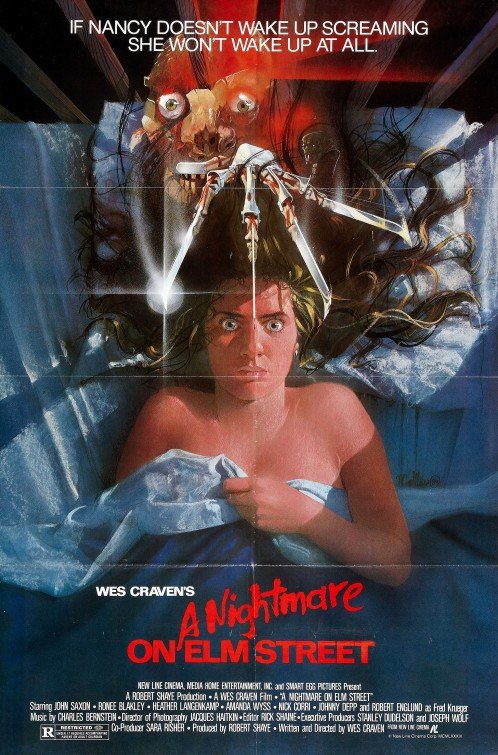A Nightmare on Elm Street: A Review
At the beginning of the year I was given the A Nightmare on Elm Street Blu-ray box set and obtained the 4-hour documentary Never Sleep Again. Since then I’ve been wanting to go through the series, review each entry, and rank them. What better time than right before Halloween?
This article will only consider the films of the proper series. The 2010 remake will not be included (word has it: nobody should watch it). I considered including 2002’s Freddy vs. Jason, but that is arguably a Jason Voorhees movie more than a Freddy movie, despite Freddy being the instigator of the plot. It’s quite a bit of fun, but I decided not to include it here. We will be looking at everything from the 1984 original to the 1994 New Nightmare.
Let’s get started!
A Nightmare on Elm Street (1984)
This film was written after director Wes Craven finished filming his adaptation of Swamp Thing. He drew inspiration from a handful of things that stuck with him: a few newspaper articles about Southeast Asian refugees who died in their sleep after having a series of nightmares and tried staying awake, a childhood memory of an old man on the street outside of his house, and a childhood bully. The former inspired the film’s story while the latter two informed the character who would anchor the story: Fred Krueger.
A group of teenagers seems to be targeted by someone or something in their dreams, brutally slaughtering them one at a time.
At the time the slasher genre was in high gear. Halloween (1978) kicked off a popular trend in horror that included the first couple Friday the 13th movies, Prom Night, When a Stranger Calls, My Bloody Valentine, The Slumber Party Massacre, and dozens of others by 1984. But they all pretty much came down to a psychopath with a blade or deadly weapon slicing and dicing. None really had anything truly creative going on. A Nightmare on Elm Street stood apart from the bunch, because it was incredibly creative. Its concept took the slasher genre inside the minds of the victims with a villain who was diabolical, featured a distinct appearance, and was frightful. Most importantly, he had a personality. There was no lumbering giant killing machine in A Nightmare on Elm Street. Fred Krueger was lean in figure. What made Krueger a great horror villain wasn’t just his iconic glove with blades on each finger and fedora. It was that he existed in dreams and could kill these teenagers immediately. But he doesn’t. Instead he toys with them for a bit. He enjoys the chase, be it through back alleys or his labyrinthine boiler room.
It’s important not to take this film for granted, as it is an expertly crafted film of its kind. It starts right away with a nightmare, establishing the threat. And then it spends a few minutes establishing the group dynamic of our main characters. The first nightmare kill comes at around the 15-minute mark. The second nightmare is 10 minutes later. This is an incredibly efficient film that doesn’t waste its time, but does allow us enough opportunity to care about the characters and understand their dynamics. It shows us rather than tells us most of the time. We get what we need to pretty quickly, as opposed to Halloween, which had much more build-up and required a psychologist to explain that film’s villain. This was Craven’s fifth film and he learned by this time to be efficient without sacrificing what was important.
What’s also interesting is the film tries to upset expectations of who might be our survivor by having Nancy (Heather Langenkamp) be Fred’s second target. Yes, Nancy famously becomes the film’s Final Girl, but, upon initial viewing, for a couple of minutes you aren’t sure that’s going to be the case as Fred corners Nancy in his boiler room.
The kills in this film are brutal and include some unforgettable imagery. One character is pulled up a wall, screaming non-stop after having her belly slashed open, and pulled onto the ceiling. Another character is pulled into his bed followed soon after by a geyser of blood. In one moment, Fred is seen pushing through a wall, in another he’s rising through a mattress. This is some pretty incredible and creative stuff.
While I won’t go into detail, the final moments, however, are up for debate. It’s surreal and ambiguous. Did Fred die? Did Nancy survive? Does any of it make sense? Regardless, A Nightmare on Elm Street endures as one of the greatest horror films of all time. It was also a financial success, earning $57 million against a $1.1 million budget. Sequels were inevitable.
A Nightmare on Elm Street 2: Freddy’s Revenge (1985)
The sequel, which follows a teen boy, whose family moves into Nancy’s house years after the original events, and becomes compelled by Freddy to kill on his behalf, was fairly rushed. The film entered pre-production in April of 1985 for a November 1st release (the day after Halloween). The core idea of the story - Freddy essentially possessing a teen (Mark Patton) until the teen becomes Freddy - is an intriguing one. But it was too much to be properly executed in a 6-month window. What we got was a film with homoerotic overtones here and there and a complete disregard for the rules set up in the original film.
While the original was efficient and to the point while still injecting character moments, the sequel had a much longer build-up. The first kill doesn’t occur until over 30 minutes. And there are only two major kills prior to the climax. Neither kill happens in dreams, because the premise calls for someone to kill in reality for Freddy using his glove, which was still in the furnace in Nancy’s home. The climax itself is chaotic, as it becomes unclear if Freddy has entered reality or if the boy has become Freddy and is raiding a pool party. Add to this an S&M death with a character literally being assaulted by balls and whipped in the butt with towels, a possessed parakeet, and another moment near the end where dogs have baby faces and you’ve got yourself a bonkers film that is a huge step below the original.
One cool moment - and it’s probably considered the money shot of the whole movie - is a metamorphosis scene where the teen boy seems to transform into Freddy, complete with knives growing out of fingertips and Freddy’s head bursting through his chest. That’s an incredible visual. But the scene is undone moments afterwards where the boy appears as himself again, which completely muddies up the film’s logic.
Overall, Freddy’s Revenge does live up to its reputation as a disappointment.
A Nightmare on Elm Street 3: Dream Warriors (1987)
After Freddy’s Revenge was a critical failure there was uncertainty whether or not a third would be made. Wes Craven never wanted his original film to become a franchise, but crafted a script for the third film with Bruce Wagner that would end the series. It turns out there were several scripts written separately by Craven, John Saxon (Nancy’s dad), and Robert Englund. Ultimately, director Chuck Russell took Craven and Wagner’s original script and retooled it significantly. This would be Russell’s directorial debut, although he wrote the script for the film Dreamscape (1984).
Ultimately, the story that resulted was about a group of teens in a psychiatric hospital who all have been having nightmares about Freddy without prior knowledge of who he is. These teens are brought together in group therapy sessions. Nancy Thompson (Heather Langenkamp) begins interning at this hospital and immediately recognizes the man in their dreams. She teams up with them in order to defeat Freddy once and for all.
Dream Warriors should have been the first sequel. It’s easy for one to forget Freddy’s Revenge existed entirely and skip immediately to this film. In fact, why this isn’t considered the case canonically, I don’t know. But Dream Warriors is a proper sequel to the original that expands on what was previously established and has more fun with the concepts, as any good sequel should do. The combination of creative ideas and practical effects makes for an awesome experience.
In this film a concept gets introduced that people can have unique powers in their dreams. The main character, Kristen Parker (Patricia Arquette in her debut), can pull people into her dreams and is acrobatic. Another character is super strong, one translates his Dungeons and Dragons fandom into wizardry, and another is a punk rocker skilled with knives. There is a mute teen who is held captive by Freddy. His power is revealed late in the film, but I bet you can guess what it is. Regardless, this is a really great idea that adds to the fun and creativity of the film. Rather than seeing a group of bratty teens get slaughtered as audiences had seen countless times by this point, we get something very different. I also like how Taryn (Jennifer Rubin) considers her mohawked punk version of herself to be beautiful. That’s novel for 1987 and a sentiment that fits perfectly with today’s teen Millennial culture.
There’s some really creative kills in this film that includes turning someone into a marionette and Freddy coming out of a television. If there is one weakness in the film it’s that these kids should know not to get close to Freddy if they don’t have to; doing so at the very least puts some in peril.
You can see, though, how this film attempted to end the story, as three key characters meet their demise. Overall, Dream Warriors is a difficult sequel to top. We have 4 more films to go, but we may have already seen the floor and ceiling in the series.
A Nightmare on Elm Street 4: the Dream Master (1988)
The Dream Master had a lot to overcome. Work on the film didn’t start until early 1988 with an August release date. This was complicated by the Writer’s Guild strike, which lasted the entire duration of the production. Also, the director they chose was Renny Harlin, a fairly new director from Finland. Now, most of Renny’s work is mediocre at best. His only good films are Cliffhanger (1993) and The Long Kiss Goodnight (1996).
The film is what you’d expect from a rushed production schedule and a mediocre director. The first act is really rough with wooden acting and the most dated hair, fashion, and soundtrack. It gets marginally better from there.
The film is a direct follow-up to Dream Warriors with the surviving patients of the psychiatric hospital attending high school together and trying to live normal lives. Freddy Krueger is resurrected and immediately goes to work finishing the job he started in Dream Warriors - and then some.
There are interesting ideas the film explores like daydreams, time loops in dreams, and Freddy’s reliance on someone bringing others to him. There are a couple of problems. The first is this is probably where the series shifts completely to making Freddy more of a humorous and cool antagonist. The film loves Freddy. That’s Harlin’s fault as he felt Freddy was the film’s hero in a way. At the same time, we are introduced to a new character named Alice, who slowly comes into her own power and we’re supposed to root for. So, the film is at odds with itself in that way. Also, the film loses touch a bit with the original concept: Freddy came to you in your dreams to kill you. He doesn’t need you to be brought to him. And, while Freddy toys with his victims, he was rarely as theatrical with his kills as he is in The Dream Master. While Dream Warriors had creative kills like the marionette and the TV, the only creative kill in this film has to do with a cockroach. But there’s even problems with how that sequence is set up. There’s a lot in the script that feels half baked or doesn’t quite make sense.
The problem at the heart of The Dream Master is: if Freddy succeeded in his revenge against all of the Elm Street kids, what’s the point? You can feel the film reaching for a reason to keep the series going. And there’s still three more films to go. After Freddy’s deaths in Dream Warriors and The Dream Master it’s getting difficult to understand how it’s possible for him to come back.
While, with a total of six deaths, it’s possible this film has the highest body count in the series, it also has silly moments like a dog pissing fire, a dojo duel, and a meatball pizza made up of souls. And the script is riddled with issues due to basically being non-existent and the production having to make things up along the way. It’s a rough watch, but you can see the potential was there.
A Nightmare on Elm Street 5: The Dream Child (1989)
It seemed after Freddy’s Revenge and The Dream Master that the series couldn’t get any worse. Unfortunately, it did.
Freddy Krueger is resurrected. Alice from The Dream Master is now pregnant and Freddy uses her unborn child’s dreams to kill her friends.
This is where the series stands firmly beyond the limits of credibility. Freddy’s resurrection makes absolutely no sense. His death has no reasoning behind it, especially compared to his previous two deaths. The mythology is clear as mud at this point. And a couple of the nightmare kills are choppy, lacking clarity or absolutely bonkers. This is also the movie where Freddy Krueger rides a skateboard and becomes a comic book super villain. The Dream Child is absolute chaos from a filmmaking perspective. It didn’t help that the MPAA required some cuts, but those largely had to do with moments of extra gore.
There’s also some of the worst acting in the series here. But what’s most important is the entire film rests on a premise that Alice has a child growing inside of her. However, the story takes place very shortly after Alice becomes pregnant. At that point her fetus is no bigger than a thimble. And her belly looks more like a first trimester belly rather than a third trimester belly. The fetus appears to be no less than 20 weeks along during most of the film. Again, this film tosses logic out the window.
Some may also find interesting the pro-life messages in the film. Alice is suggested the option of having an abortion to kill Freddy’s scheme. There’s also a confrontation between Alice and the father’s parents about who should have custody of the child. There was an intention there, but it’s largely abandoned and lost among the chaos.
Overall, we have a film that even the director Stephen Hopkins (Predator 2, Lost in Space) is embarrassed about. It is worth only a single viewing by the biggest fans of the series.
Freddy’s Dead: The Final Nightmare (1991)
New Line Cinema decided to end the Elm Street franchise and long-time producer of the series, Rachel Talalay stepped up to the plate as director. This film is set 10 years in the future by which point all but one of the adolescents in Springwood have been killed by Freddy Krueger. The lone survivor (Shon Greenblatt) escapes, but is found by Freddy with the hopes that he will bring more potential victims back to Springwood. After being found in a nearby town and sent to a youth center, he, one of the center’s counselors (Lisa Zane), and a group of teens end up back in Springwood and are trapped there.
Admittedly, when explaining the plot not a lot makes sense. There’s even ideas of dream demons that may have made a deal with Freddy in exchange for eternal life. Not a lot of it is all that coherent. What are and actually provides some interest are scenes that show some of Freddy’s history. They don’t take up much of the 80+ minute runtime, so they’re efficient without sacrificing coherence. They are some of the most interesting scenes for some time in the series. There are even secrets in the film that provide more logic to Freddy’s undoing than anything in The Dream Master and The Dream Child.
However, Talalay’s worst creative mistake is to add more humor to the film than in previous entries. There’s more Looney Tunes in Freddy’s Dead than in any of the other films - and that’s not a good thing. In a way, it completes the progression away from the tone of the original that the series has been making for the better part of the past couple of films. But it is sequences like the video game kill that do the most harm to the film. Is it fun seeing Freddy playing with a video game controller or his own version of the Nintendo Power Glove? Sort of. The results will make you shake your head, though, as it stretches way beyond reality and horror. And then there’s the 3D gimmick, which completely falls flat today, especially since the home video print is completely in 2D.
Overall, Freddy’s Dead is a funhouse version of an Elm Street movie. It’s unfortunate, because there are some interesting ideas here and there that prevent it from being the absolute worst in the series. But it is a far cry from the best.
Wes Craven’s New Nightmare (1994)
As the title suggests, Wes Craven came back to the film series for one last entry. This would be unlike any of the other films in the series and much closer in tone to the original, which was sorely missed.
New Nightmare supposes that the character Freddy Krueger is actually an ancient force of evil that’s been trapped in the film series for the better part of the decade. Now that the series was concluded, that evil is free once again and can only be trapped again by producing another Nightmare movie. It’s a somewhat contrived concept that almost sticks the landing in the climax, which I think is why most people boil it down to the simpler “Freddy tries to enter our world” concept. It stars Heather Langenkamp as herself being terrorized by earthquakes, a stalker, her freaky son (Miko Hughes), and Freddy Krueger himself.
The tone here is darker, more serious, absent of humor, which makes the film much more successful and one of the best of the series. There aren’t many kills in the film. But that’s okay. Freddy’s Revenge didn’t have many kills either and it also had a high concept - but New Nightmare actually met its ambitions where Freddy’s Revenge did not.
What’s also interesting in hindsight is how many elements in New Nightmare ended up in Scream, even though Craven didn’t write the script for Scream: the terrorizing and repetitive phone calls, the meta commentary on the horror genre tropes and how the films affect people’s psychology and behavior. All of that are essential elements of Scream.
Regardless, New Nightmare gave the series the end it needed: a film with scares, intelligence, and creativity that comes full circle back to the original Nightmare.
The Rankings
Now it’s time to rank the films in the series and crown the best in 3 categories: Poster, Final Girl, and Kill.
Best Poster
There were a lot of cool and creative posters in the ‘80s, especially in the horror genre. The Elm Street series was no exception. Poster artist Matthew Peak designed the first five posters. I’m not sure why he was abandoned for the last couple of films, as the resulting posters definitely pale in comparison.
While the poster for Dream Warriors is among the coolest of the decade with the combination of Freddy’s face, his claws, the Thompson house, and the four distinct teens ready to fight it falls just short of the original film’s poster, my pick for best in the series. The image of the girl in bed, eyes wide awake, her hair sprawled out across the pillow, with Freddy’s claws hovering over her head is one of the most iconic poster images of the ‘80s. It is an excellent design.
Best Final Girl
The Elm Street series had 5 heroines: Nancy Thompson, Lisa Webber, Kristen Parker, Alice Johnson, and Maggie Burroughs. They run the full spectrum from forgettable to iconic. While most were pretty good, the best is the girl who basically fought Freddy three times in seven movies: Nancy Thompson. Nancy proved herself smart enough in the original film to outwit Freddy every time she encountered him. It was wonderful seeing her return in the third film. And she basically came back in the final film, New Nightmare, when actress Heather Langenkamp was forced to play Nancy in order to defeat Freddy once and for all. Nancy was in the best films in the series and she’s one of the reasons they are so good.
Best Kill
One of the great elements about A Nightmare on Elm Street is how creative it can be with its kills. The villain hunts its victims in their dreams, so anything can happen. However, a lot of the time he just stabs them in the chest once they’re foolish enough to get too close. As the series went on the ideas went over-the-top. But there were a few that were notable. Dream Warriors, in particular, had a couple of the coolest and most creative kills in the entire series. But the best has to be the one that takes place 15 minutes into the entire series: Tina’s death. After toying with Tina for a bit, getting her plenty freaked out, Freddy goes for the kill in her bedroom. He slices open her chest and drags her up the wall and onto the ceiling. Meanwhile, her boyfriend - and the audience - looks on in dismayed horror. This is probably the most frightening and effective kill in the entire series. Primarily because there’s about 4 minutes of terrifying preamble and then the actual kill lasts for a full minute or two, all the while Tina is screaming in absolute terror. It may not be a comic book or an exploding head, but for any new viewer this scene set the stage of how the kills look in reality and that anything is possible. It was so good Craven remade it in New Nightmare.
The Movies Ranked
A Nightmare on Elm Street
Wes Craven’s New Nightmare
A Nightmare on Elm Street 3: Dream Warriors
A Nightmare on Elm Street 4: The Dream Master
Freddy’s Dead: The Final Nightmare
A Nightmare on Elm Street 2: Freddy’s Revenge
A Nightmare on Elm Street 5: The Dream Child
That completes our look at the A Nightmare on Elm Street film series. In a decade stuffed with brutal slasher films this series stands apart for its creativity. Even though it strayed from the original tone and muddied up its mythology, the series often had ideas that were far more interesting and creative than the rest of its contemporaries.
As mentioned earlier there was a crossover film, Freddy vs. Jason, that I recommend as it just falls short of meeting the years-long anticipation at the time. But I especially highly recommend the 270+ minute documentary, Never Sleep Again. It is a single film and it is an exhaustive look at the entire franchise. Every fan should see it.
What are your thoughts? Do you agree with my reviews and rankings? Comment below.













